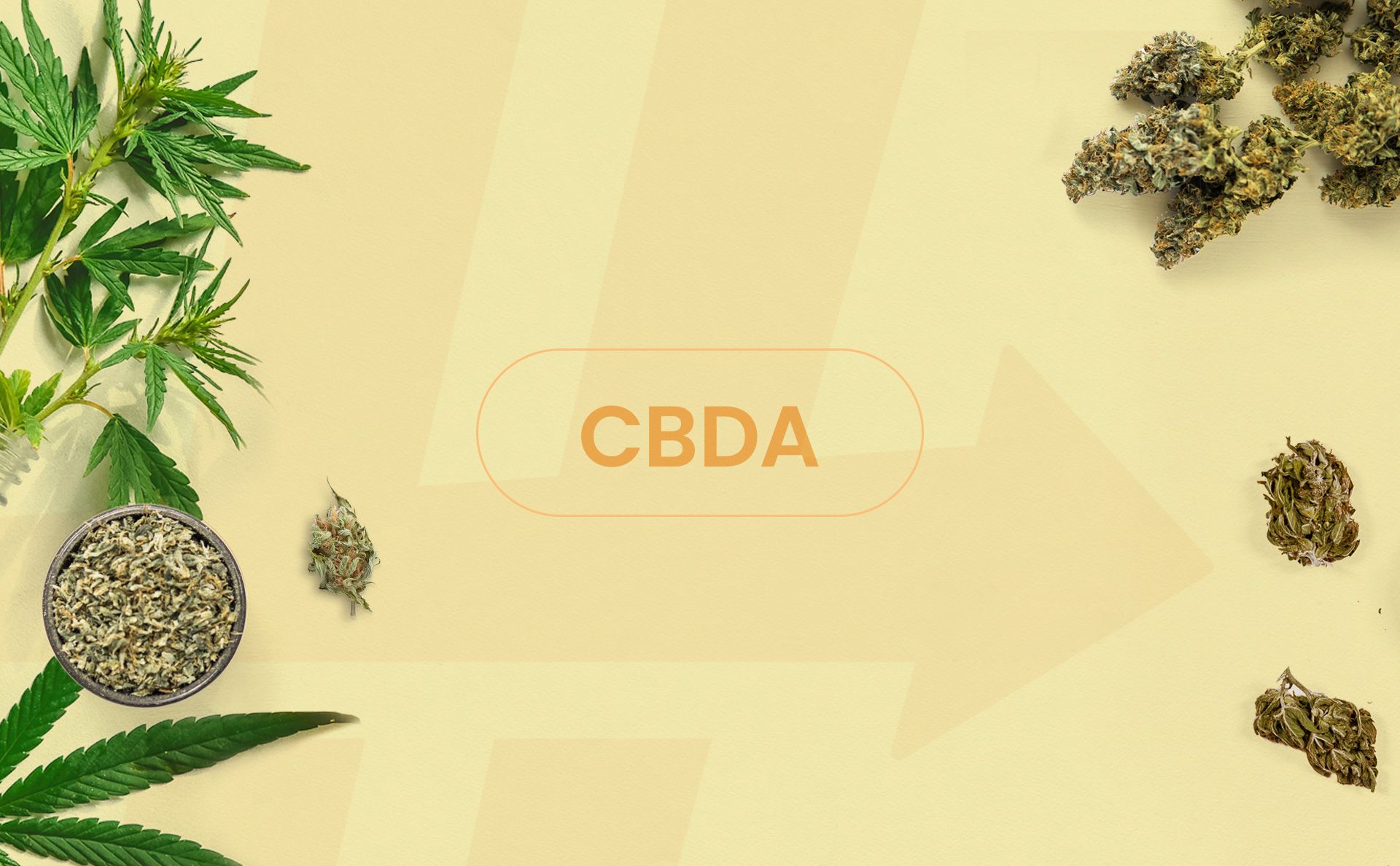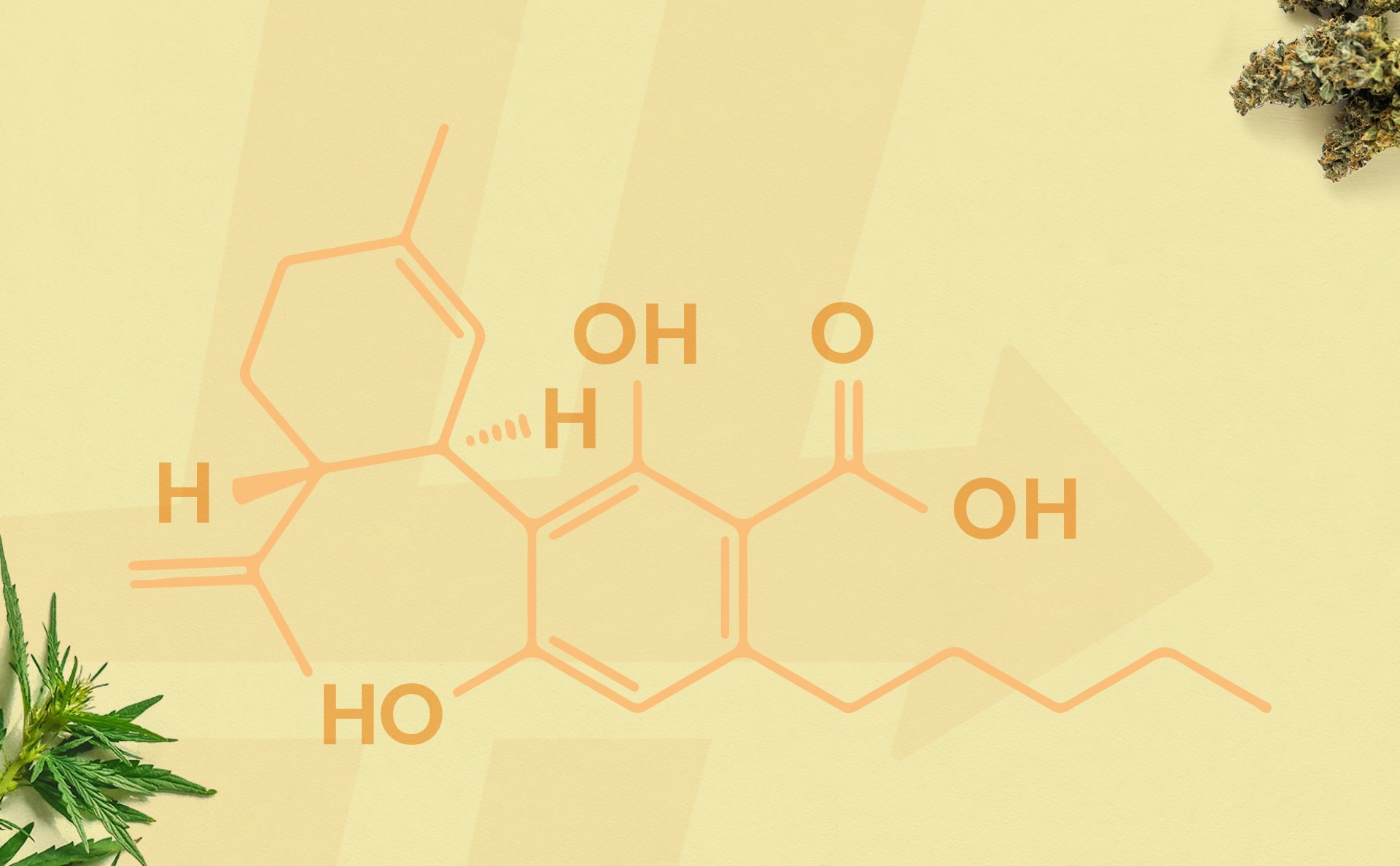CBDA
What is CBDA? In this chapter of our cannabinoids guide, we discuss what this compound is, what its effects are, and if there are any potential benefits.

What is CBDA?
CBDA, or cannabidiolic acid, is the most common acidic compound found in the cannabis plant. CBDA acts as a precursor, or parent, to the much better-known cannabinoid CBD. Essentially, CBDA is the raw form of CBD.
When CBDA is dominant in a cannabis plant, it’s called type III cannabis by researchers, or simply hemp. Since cannabis plants generally favor making one of the acidic cannabinoids over another, high CBDA cultivars carry low amounts of other acidic cannabinoids (e.g. THCA or CBGA).
CBDA is quite delicate and requires special handling to extract and process. When exposed to heat, certain extraction processes, air, long shelf-life, or even digestion – CBDA readily converts to CBD in a short time. This process is known as decarboxylation. The amount of time this process takes depends on the cultivar, the temperature, and the type of heat or extraction used, but happens pretty fast if not careful.
CBDA is plentiful in high-CBD cultivars and hemp carrying low THC. We can find this compound in products such as capsules, topicals, and tinctures. Juicing raw cannabis leaves is also a popular consumption method for ingesting CBDA and CBD. Keep in mind, blender heat may degrade some or even all the CBDA into CBD.

Effects of CBDA
Like its close relative CBD, CBDA is a non-impairing compound. Unlike THC, CBDA will not make consumers feel high.
Instead, CBDA quickly breaks down into CBD in the body. CBDA is 1000 times more potent than CBD at serotonin receptors. Breaking down into CBD increases levels of anandamide, a feel-good endocannabinoid that helps alleviate anxiety and regulate mood, among other things.
Because of this, some beginner consumers of CBD and CBDA products may feel a profound sense of relief, unlike anything they’ve ever experienced. This can result in relaxation, antidepressant effects, and stress relief.

What the expert says...
Dr. Abraham Benavides
"CBDA is the parent to CBD, and is about three times better absorbed than neutral CBD. Since CBDA quickly degrades into CBD, including within the body, this means you can likely reap the benefits of CBD and CBDA at lower doses."
Potential Benefits of CBDA
Much like its close relative CBD, many scientific studies have been conducted on CBDA. The vast majority of these students were done on rodents in a laboratory setting. Researchers have been observing the reactions lab mice have to CBDA since 2003.
To be clear, there aren't any clinical studies done yet on CBDA. This means that the potential benefits aren’t confirmed, and are not yet fully known. Based on animal and computer studies, CBDA may be:
- Pain relieving
- Anti-inflammatory (with selective COX-2 inhibition, like Celecoxib)
- Anti-nausea and anti-vomiting (at lower doses than CBD in mice)
- Neuroprotective (benefits in mice models of Alzheimer’s and Parkinson’s)
- Anticonvulsant (also at lower doses)
- Antidepressant (more effective in male mice than female)
- Potentially beneficial for chronic liver diseases
- Preventing SARS-Co-V-2 entry into cells for infection, and potentially easing symptoms
- Anticancer effects on various leukemia and breast cell cancer types
Potential Side Effects of CBDA
CBDA is delicate and quickly metabolizes into CBD in the body. You may notice increased effectiveness over CBD, since CBDA is estimated to be three times better absorbed than regular CBD. It’s also better absorbed within an hour or two after meals.
On the other hand, increased absorption also means you are more likely to experience side effects at lower doses than plain CBD. You could experience mild, temporary side effects that are common to CBD, such as:
Gastrointestinal disturbance Tiredness and sleepiness Loss of appetite Increased liver enzymes
CBDA is generally safe and well-tolerated. Serious side effects are rare, but may occur if taken with anti-epileptic medications. It’s important to tell your doctor about any cannabinoid use, including CBDA and CBD.
What We Learned: CBDA
CBDA is just one of the many cannabinoids and other potentially beneficial compounds in whole-plant cannabis medicine. Here’s what else we learned about CBDA:
- CBDA, or cannabidiolic acid, is the raw form of CBD.
- Because of the acidic group, CBDA is estimated to be three times better absorbed into the body (bioavailable) than neutral CBD.
- When exposed to heat, extraction processes, air, long shelf time, and even digestion, CBDA converts to CBD quickly and easily.
- CBDA is plentiful in high-CBD cultivars and hemp, and CBDA dominance defines type III cannabis.
- Like its close relative CBD, CBDA is non-impairing, but increases good-feeling endocannabinoids and mood receptors.
- Unlike THC, CBDA will not make you feel high.
- Beginner consumers of CBD and CBDA products may feel a profound sense of relief, unlike anything they’ve ever experienced. This can result in relaxation, antidepressant effects, and antianxiety benefits.
- Researchers have been observing the reactions lab mice have to CBDA since 2003.
- CBDA interacts with our serotonin receptors similarly to selective serotonin reuptake inhibitor (SSRI) antidepressant medications, and with 1000 times the strength of regular CBD
- CBDA quickly breaks down into CBD in the body, so you may expect a similar profile of potential benefits and side effects – but both may come at lower doses than CBD.
Ready to keep moving towards completing this guide? Answer the question below and let’s advance.
Citations
- Barré, T., Di Marzo, V., Marcellin, F., Burra, P., & Carrieri, P. (2023). Expanding Research on Cannabis-Based Medicines for Liver Steatosis: A Low-Risk High-Reward Way Out of the Present Deadlock? Cannabis and Cannabinoid Research, 8(1), 5–11.https://doi.org/10.1089/can.2022.0014
- Berk, K., Bzdega, W., Konstantynowicz-Nowicka, K., Charytoniuk, T., Zywno, H., & Chabowski, A. (2021). Phytocannabinoids—A Green Approach toward Non-Alcoholic Fatty Liver Disease Treatment. Journal of Clinical Medicine, 10(3), 393.https://doi.org/10.3390/jcm10030393
- Cannabidiolic Acid (CBD-a) Cannabinoid Research. (2024). Cannakeys. Retrieved October 2, 2024, fromhttps://cannakeys.com/cannabidiolic-acid-cbd-a-cannabinoid-research/
- Filer, C. N. (2023). Delta-9-Tetrahydrocannabinolic Acid B: A Mechanism for its Formation in Cannabis. Cannabis and Cannabinoid Research, 8(1), 1–4.https://doi.org/10.1089/can.2021.0216
- Formato, M., Crescente, G., Scognamiglio, M., Fiorentino, A., Pecoraro, M. T., Piccolella, S., Catauro, M., & Pacifico, S. (2020). (‒)-Cannabidiolic Acid, a Still Overlooked Bioactive Compound: An Introductory Review and Preliminary Research. Molecules, 2https://doi.org/10.3390/molecules25112638
- Hen-Shoval, D., Moshe, L., Indig-Naimer, T., Mechoulam, R., Shoval, G., Zalsman, G., Kogan, N. M., & Weller, A. (2023). Cannabinoid Receptor 2 Blockade Prevents Anti-Depressive-like Effect of Cannabidiol Acid Methyl Ester in Female WKY Rats. Internationalhttps://doi.org/10.3390/ijms24043828
- Hill, K. P., & Abrams, D. I. (2021). A cannabis oracle? Delphi method not a substitute for randomized controlled trials of cannabinoids as therapeutics. Journal of Cannabis Research, 3(1), 23.https://doi.org/10.1186/s42238-021-00074-0
- Janecki, M., Graczyk, M., Lewandowska, A. A., & Pawlak, Ł. (2022). Anti-Inflammatory and Antiviral Effects of Cannabinoids in Inhibiting and Preventing SARS-CoV-2 Infection. International Journal of Molecular Sciences, 23(8), 4170.https://doi.org/10.3390/ijms23084170
- Kim, J., Choi, P., Park, Y.-T., Kim, T., Ham, J., & Kim, J.-C. (2023). The Cannabinoids, CBDA and THCA, Rescue Memory Deficits and Reduce Amyloid-Beta and Tau Pathology in an Alzheimer’s Disease-like Mouse Model. International Journal of Molecular Sciencehttps://doi.org/10.3390/ijms24076827
- Krämer, M., Schäper, M., Dücker, K., Philipsen, A., Losacker, M., Dreimüller, N., Engelmann, J., Madea, B., & Hess, C. (2021). Detectability of cannabinoids in the serum samples of cannabis users: Indicators of recent cannabis use? A follow-up study. Drughttps://doi.org/10.1002/dta.3110
- Madeo, G., Kapoor, A., Giorgetti, R., Busardò, F. P., & Carlier, J. (2023). Update on Cannabidiol Clinical Toxicity and Adverse Effects: A Systematic Review. Current Neuropharmacology.https://doi.org/10.2174/1570159X21666230322143401
- Mboumba Bouassa, R.-S., Sebastiani, G., Di Marzo, V., Jenabian, M.-A., & Costiniuk, C. T. (2022). Cannabinoids and Chronic Liver Diseases. International Journal of Molecular Sciences, 23(16), 9423.https://doi.org/10.3390/ijms23169423
- Mlost, J., Bryk, M., & Starowicz, K. (2020). Cannabidiol for Pain Treatment: Focus on Pharmacology and Mechanism of Action. International Journal of Molecular Sciences, 21(22), 8870.https://doi.org/10.3390/ijms21228870
- Souza, J. D. R., Pacheco, J. C., Rossi, G. N., de-Paulo, B. O., Zuardi, A. W., Guimarães, F. S., Hallak, J. E. C., Crippa, J. A., & Dos Santos, R. G. (2022). Adverse Effects of Oral Cannabidiol: An Updated Systematic Review of Randomized Controlled Trialshttps://doi.org/10.3390/pharmaceutics14122598
- Suryavanshi, S. V., Kovalchuk, I., & Kovalchuk, O. (2021). Cannabinoids as Key Regulators of Inflammasome Signaling: A Current Perspective. Frontiers in Immunology, 11, 613613.https://doi.org/10.3389/fimmu.2020.613613
- van Breemen, R. B., Muchiri, R. N., Bates, T. A., Weinstein, J. B., Leier, H. C., Farley, S., & Tafesse, F. G. (2022). Cannabinoids Block Cellular Entry of SARS-CoV-2 and the Emerging Variants. Journal of Natural Products, 85(1), 176–184.https://doi.org/10.1021/acs.jnatprod.1c00946
- Wakshlag, J. J., Schwark, W. S., Deabold, K. A., Talsma, B. N., Cital, S., Lyubimov, A., Iqbal, A., & Zakharov, A. (2020). Pharmacokinetics of Cannabidiol, Cannabidiolic Acid, Δ9-Tetrahydrocannabinol, Tetrahydrocannabinolic Acid and Related Metabolites inhttps://doi.org/10.3389/fvets.2020.00505
- Walsh, K. B., McKinney, A. E., & Holmes, A. E. (2021). Minor Cannabinoids: Biosynthesis, Molecular Pharmacology and Potential Therapeutic Uses. Frontiers in Pharmacology, 12, 777804.https://doi.org/10.3389/fphar.2021.777804
Test your knowledge, track your progress and earn your badge.
What happens to CBDA when exposed to heat?

Dr. Abraham Benavides
Dr. Abraham Benavides is an internationally-recognized cannabis research expert, experienced medical advisor, and full-tuition merit scholar of the George Washington University School of Medicine and Health Sciences. Dr. Abe enjoys helping patients as a writer, educator, and cannabis health coach at the GW Center for Integrative Medicine.